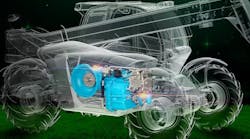Keeping the numbers down
Last month, we took you inside the federal government's safety rating process. Over the next few months, we'll look at the individual factors that make up a fleet's overall safety rating.
As a reminder, a carrier's safety rating is determined by its ability to demonstrate compliance in the following areas:
* Accident rate
* Vehicle factors, including inspection, repair, and maintenance
* Operational factors such as hours of service
* Driver regulations, including qualification, licensing, and drug and alcohol testing
* General factors like insurance
* Transportation of hazardous materials
The first element that goes into determining an overall safety rating is the fleet's accident rate. Unlike other factors, there's no conditional rating when it comes to accidents. Either you've got it or you don't. There's no gray area.
To achieve a rating of "satisfactory," fleets must have no more than 1.5 recordable accidents per million-vehicle-miles traveled. Urban and regional operations must have an accident rate of no more than 1.7 accidents per million miles traveled. Anything higher is considered unsatisfactory.
If a fleet receives an unsatisfactory rating in this area, the best overall rating it can receive is "conditional." So it's of the utmost importance that fleets do everything possible to bring their accident rate below the threshold.
Dept. of Transportation (DOT) data show that roughly 15% of the nation's motor carriers cannot meet that threshold.
Exactly how does DOT define "recordable"? A recordable accident is any incident - regardless of whether or not it could have been prevented - involving a commercial motor vehicle operating on a highway in either interstate or intrastate commerce that results in:
* A fatality;
* Bodily injury to a person who is taken away from the scene of the crash for immediate medical attention;
* One or more motor vehicles incurring disabling damage that makes it necessary to transport it away from the scene by a tow truck or other motor vehicle.
"It's a highway if the public has access," explains Jim York, director of safety programs for the National Private Truck Council (NPTC). "So a parking lot qualifies. If you have a truck parked in a strip-mall parking lot and your driver is out making the delivery while somebody rams the unit and needs to be towed away, you've just had a recordable accident - even though you did absolutely nothing wrong."
York argues that fleets should take a more proactive role in minimizing their exposure to accidents. "Most incidents, even the most trivial, begin with a series of alterable events," he explains. "The difference in outcome is often just dumb luck." That being the case, fleets should "aggressively manage each incident, trivial or not, as if the company's viability depends on its outcome," York urges.
This means determining the sequence of actions preceding an event to learn what can be done to break the chain. The time to think about breaking the chain of events is well in advance of any incident.
Take each and every incident seriously, whether it's a fender bender or a recordable event, and use it to understand why it happened in the first place.
Could communications between drivers, fleets, and repair facilities be improved? Could equipment specs be changed to ensure more safe and reliable operations? Could driver training programs be tailored to better minimize the likelihood of similar incidents in the future?
"My guess is that you'll reap many rewards from such an approach," says York. "Not only will it stop the bleeding (financial as well as physical), but you'll see a dramatic impact on your insurance loss runs and premiums."
The loss-run reports generated by insurance companies (an itemized list of claims and the money paid out for each), can provide valuable information about accident trends, including time of day, location, routes, and drivers. Use this data to improve your fleet's safety record.


